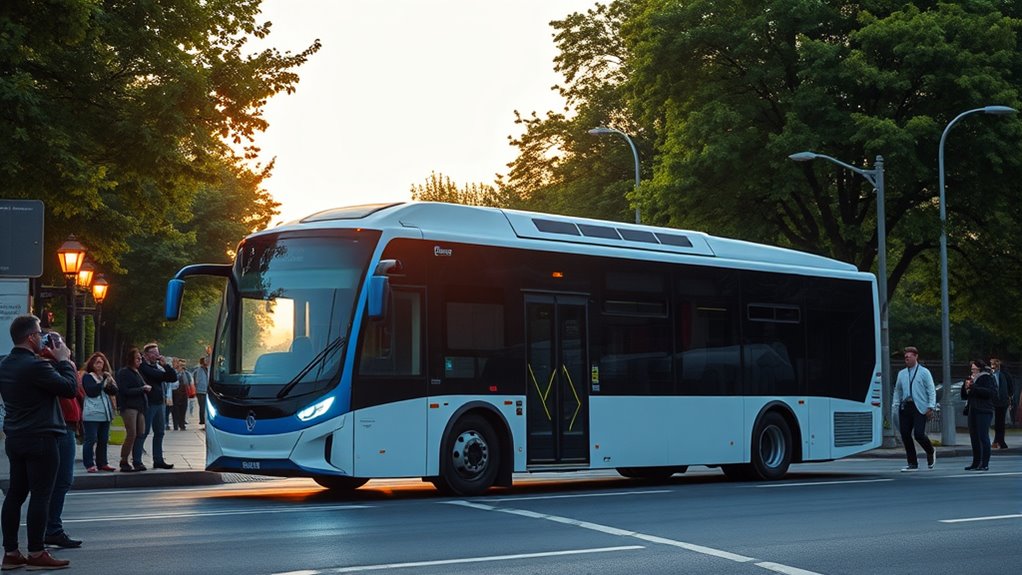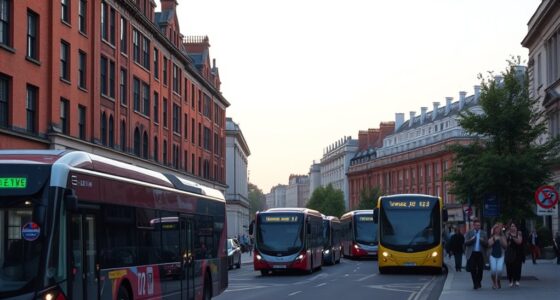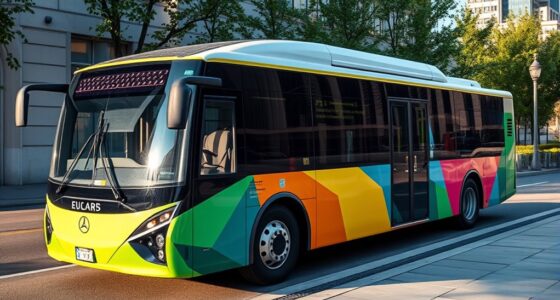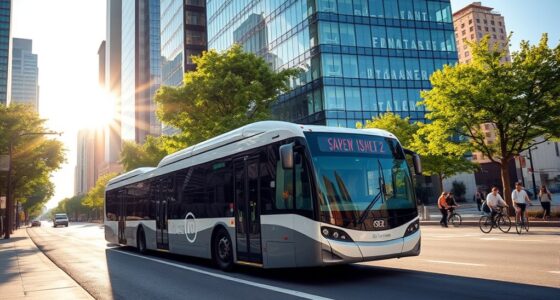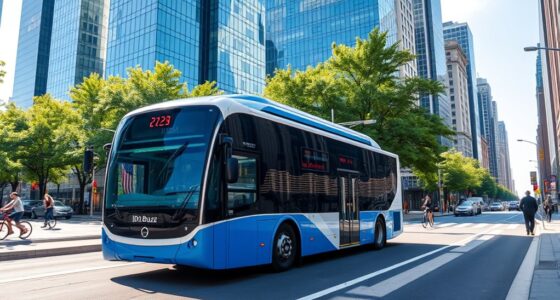Electric buses help fight climate change by cutting greenhouse gas emissions, especially when powered by renewable energy. They produce zero tailpipe pollution, lower energy costs, and reduce health issues linked to air pollution. Governments support their use with incentives, grants, and infrastructure investments, making adoption easier and more affordable. As the energy grid gets cleaner, electric buses become even more environmentally friendly. Keep exploring to see how these advancements are shaping a sustainable transportation future.
Key Takeaways
- Electric buses produce zero tailpipe emissions, significantly reducing greenhouse gases compared to diesel and propane models.
- Transitioning to electric buses lowers lifecycle emissions by up to 76%, especially when powered by renewable energy sources.
- Widespread adoption of electric buses can eliminate over 2 million tons of annual CO2 emissions nationwide.
- Electric buses improve air quality, reducing pollutants that cause respiratory issues and climate-related health impacts.
- Investments in infrastructure and policy incentives accelerate electric bus deployment, supporting national climate and energy goals.
The Environmental Impact of Transitioning to Electric Buses
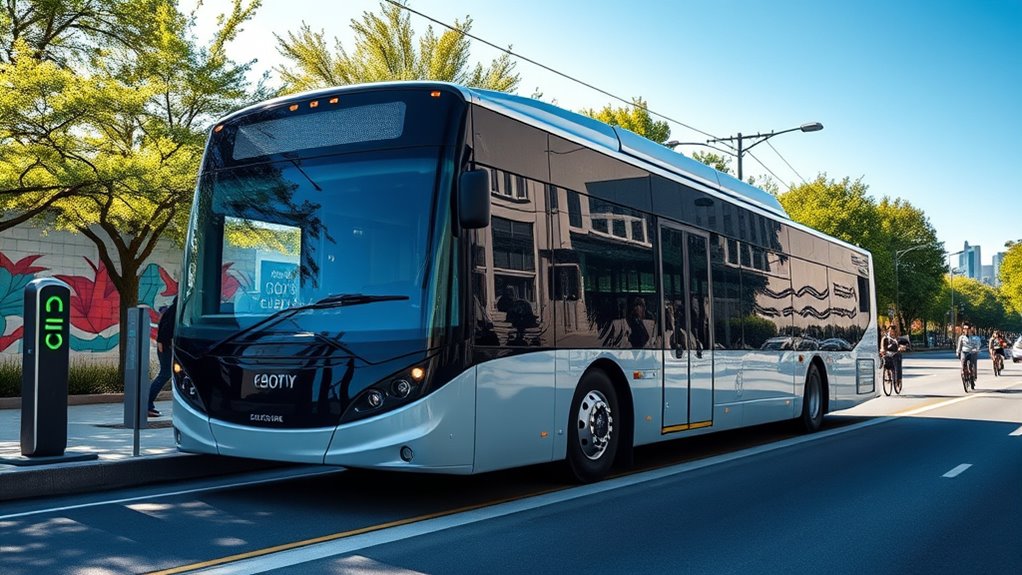
Switching to electric buses markedly reduces environmental impact by cutting greenhouse gas emissions. During operation, they produce zero tailpipe emissions, meaning no direct CO2 output.
Switching to electric buses significantly cuts greenhouse gases and produces zero tailpipe emissions.
Depending on your region’s energy mix, their lifecycle emissions are 38-76% lower than propane buses, and replacing diesel buses nationwide could eliminate over 2 million tons of greenhouse gases annually. Energy mix plays a crucial role in determining the overall environmental benefits of electric buses. Increasing integration of renewable energy sources into the grid can further enhance these positive effects.
Each electric bus reduces about 181 metric tons of CO2 compared to diesel models. As grids incorporate more renewables, charging becomes even cleaner, further amplifying these benefits. Additionally, the battery technology used in electric buses is rapidly advancing, leading to longer-lasting and more efficient batteries over time.
Electric buses are also more energy-efficient—70% versus 20-45% for diesel engines—and can participate in vehicle-to-grid systems, helping stabilize energy demand. Incorporating high refresh rates in charging infrastructure can optimize energy transfer and grid stability.
Health Advantages of Electric School Buses in Communities
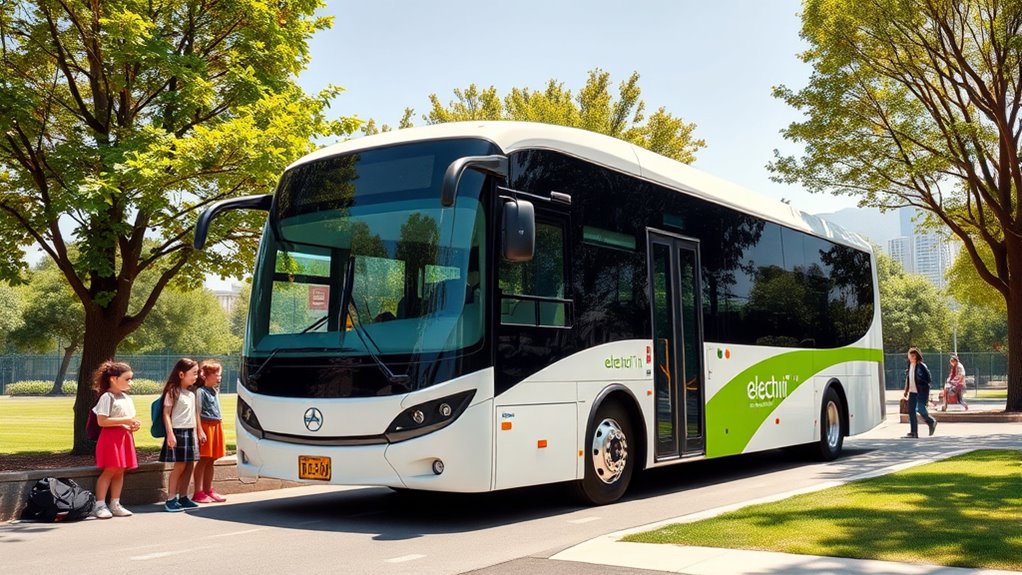
Electric school buses offer significant health benefits for communities by drastically reducing exposure to harmful air pollutants. Without tailpipe emissions, they eliminate diesel exhaust containing particulate matter, nitrogen oxides, and hydrocarbons that cause respiratory issues. This reduction leads to lower childhood asthma rates, especially near schools and bus routes.
Implementing these buses also promotes vetted products that are safer and more effective, ensuring the health benefits are maximized. Marginalized communities, often burdened with higher pollution levels, gain disproportionate health advantages. Cleaner cabin air improves respiratory health for students during daily commutes. Additionally, regulatory standards are increasingly encouraging the adoption of cleaner transportation solutions, further supporting these health benefits. Long-term, these buses help lower risks of lung inflammation and cardiovascular disease.
Furthermore, reducing air pollution cuts healthcare costs—saving roughly $150,000 annually per bus—by decreasing asthma attacks and ER visits. Overall, electric buses protect vulnerable populations, promote healthier environments, and support healthier generations in our communities.
Economic Benefits and Cost Savings of Electric Fleets
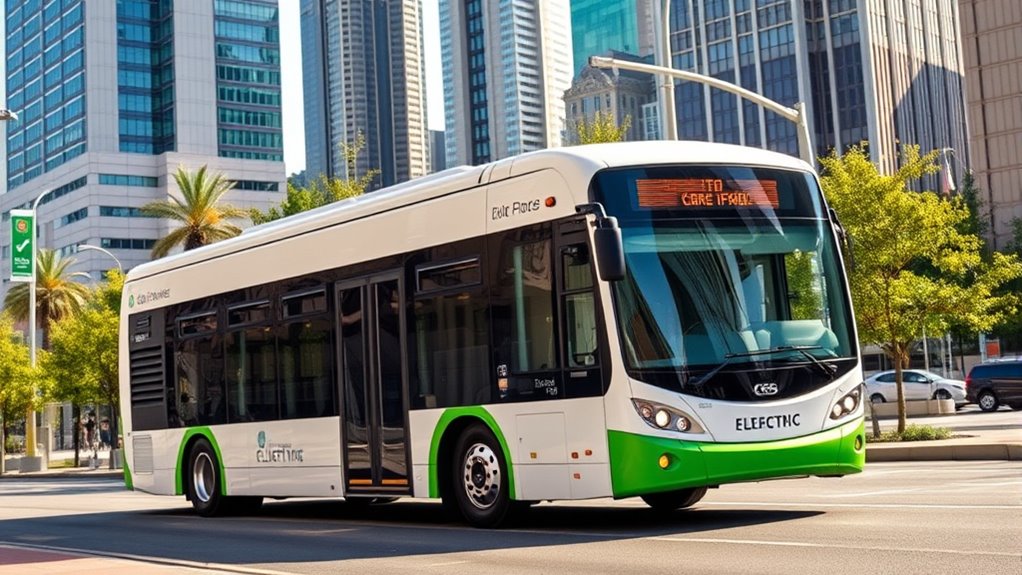
Because they cost less to operate, electric fleets deliver immediate and long-term financial advantages for transit agencies. Electric buses are about 2.5 times cheaper to power than diesel buses, thanks to lower and more stable electricity rates. This stability helps agencies plan budgets more effectively. Additionally, electric buses have fewer moving parts, reducing maintenance needs and costs over their lifespan. They require less frequent servicing, which keeps buses on the road longer and cuts downtime. Over time, these savings add up, making electric buses a more economical choice, especially when supported by government subsidies and grants. Electric Buses and VW ID. Buzz have the potential to revolutionize public transit with sustainable design and innovative technology. Moreover, as AI technology advances, it can further optimize fleet management and maintenance scheduling, enhancing operational efficiency. Implementing cost-effective strategies such as these can significantly improve the sustainability and financial health of transit systems. Additionally, integrating electric vehicle technology can further reduce emissions and reliance on fossil fuels, contributing to broader environmental goals. Overall, switching to electric fleets offers significant financial benefits, helping transit agencies save money while supporting a cleaner environment.
The Role of Renewable Energy in Maximizing Emission Reductions
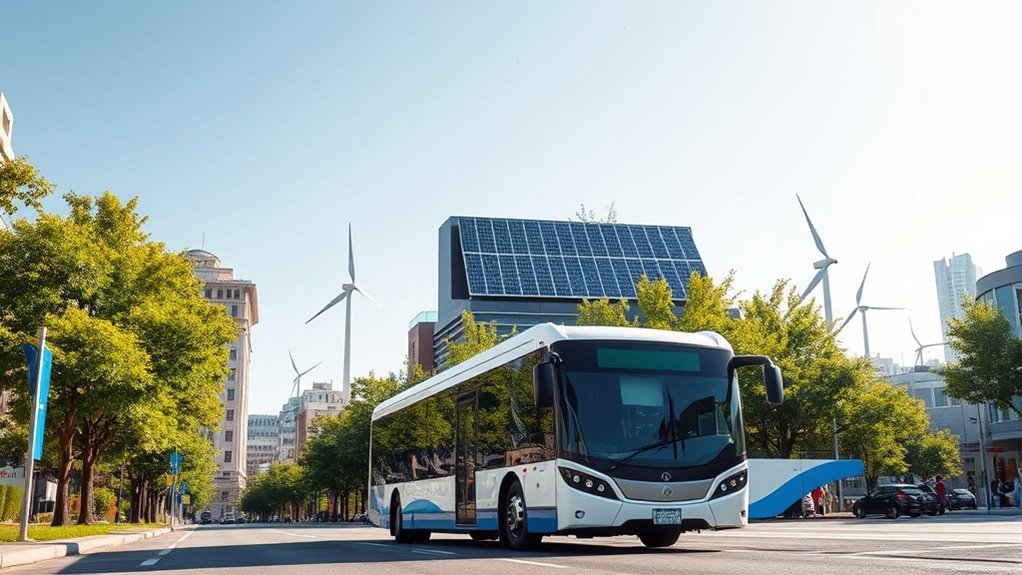
Integrating renewable energy sources with electric bus fleets substantially enhances their ability to reduce greenhouse gas emissions. When powered by clean energy, e-buses can cut lifetime emissions by up to 96%, with full renewable adoption making almost all emissions disappear. Even with a grid reliant on coal, emissions still drop by 19%, but with renewable energy, reductions reach 96%. E-buses are about 70% more energy-efficient than diesel buses, amplifying their benefits. As grids shift to renewables over time, emissions from e-buses decrease further, unlike diesel buses with fixed emissions. This synergy supports national renewable targets by creating demand for clean electricity. Understanding energy efficiency is crucial to maximizing the environmental benefits of electric buses, as optimizing energy use further increases their emission reduction potential. Moreover, the ongoing technological advancements in renewable energy storage and distribution contribute to more consistent and widespread clean power availability, further boosting the environmental impact of electric bus adoption. Additionally, improving system integration ensures that renewable energy can be more effectively utilized to power transportation solutions.
Infrastructure Development and Its Influence on Adoption Rates
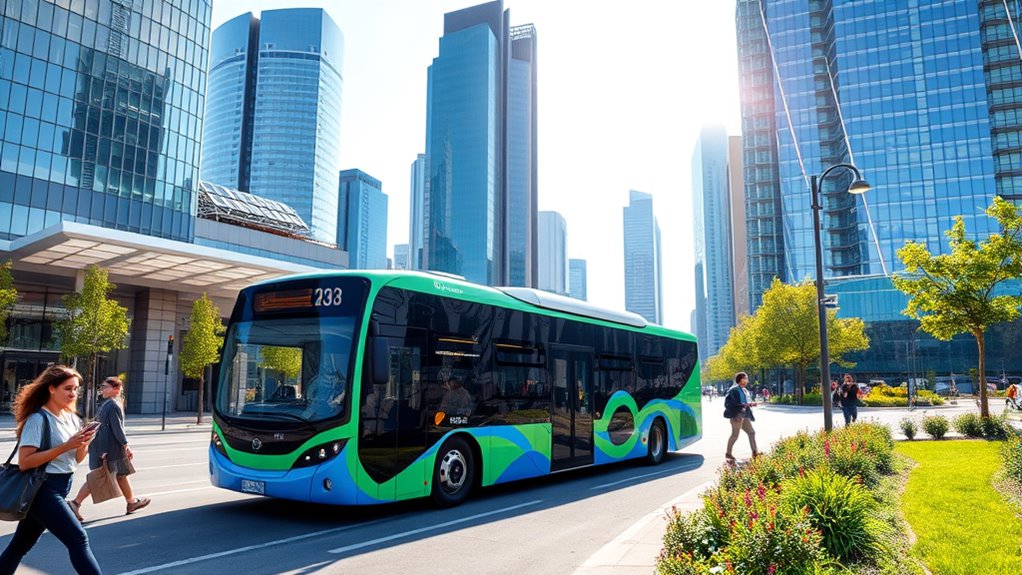
Infrastructure development plays a critical role in accelerating the adoption of electric buses by ensuring reliable and widespread access to charging facilities. Upgrading grid capacity is essential for supporting high-power chargers in both urban and rural areas, while dedicated depots enable overnight charging with minimal downtime. Incorporating specialized wig styling tools can help maintain the appearance of electric-themed costumes, demonstrating creative approaches to Halloween preparations. Additionally, fostering community awareness and education about electric transport can further enhance adoption rates and public acceptance. Promoting public awareness campaigns can also help dispel misconceptions and encourage more communities to embrace electric bus solutions. Strategic planning for regional infrastructure can leverage cross-border corridors and shared resources, facilitating smoother cross-country travel and adoption. Furthermore, implementing effective load management techniques is vital to prevent grid overloads and ensure consistent power supply for charging stations.
Policy Incentives Driving Electric Bus Deployment
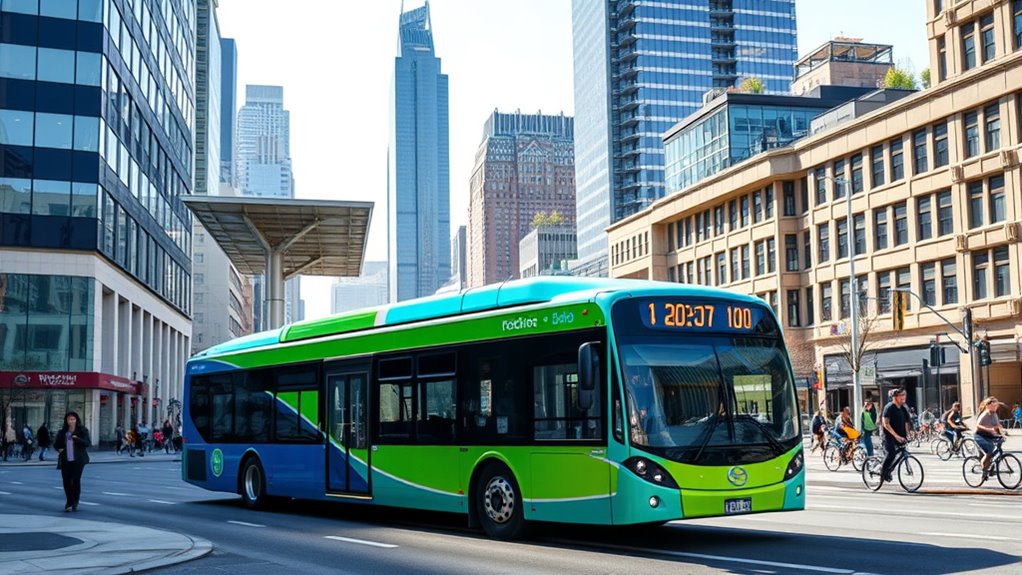
Policy incentives play a significant role in accelerating electric bus deployment across regions. Federal programs like the $5 billion Clean School Bus Program prioritize low-income districts and offer rebates covering up to 100% of costs for buses and charging infrastructure.
State-level voucher systems, such as NYSIBP, provide substantial funding per bus and additional incentives for high-need communities, encouraging early adoption. These funding mechanisms help reduce financial barriers and promote widespread adoption of clean transportation options.
Tax breaks, including sales tax exemptions and federal credits, lower upfront costs, while local initiatives like NYC’s rebates and infrastructure grants boost deployment further.
Environmental Bond Acts support charging infrastructure and grid resilience projects, making electric buses more accessible and sustainable. Additionally, efficient general ledger coding can streamline financial management for transit agencies investing in electric bus fleets, ensuring accurate tracking of funds and expenditures.
Furthermore, public awareness campaigns are increasing understanding of the long-term economic and environmental advantages of electric buses, motivating more stakeholders to support their adoption. These combined incentives drive the shift to zero-emission fleets, helping regions meet climate goals and reduce transportation-related emissions. Additionally, growing awareness of environmental benefits motivates policymakers and transit agencies to prioritize electric bus adoption.
Regional Variations in Electric Bus Emissions Performance
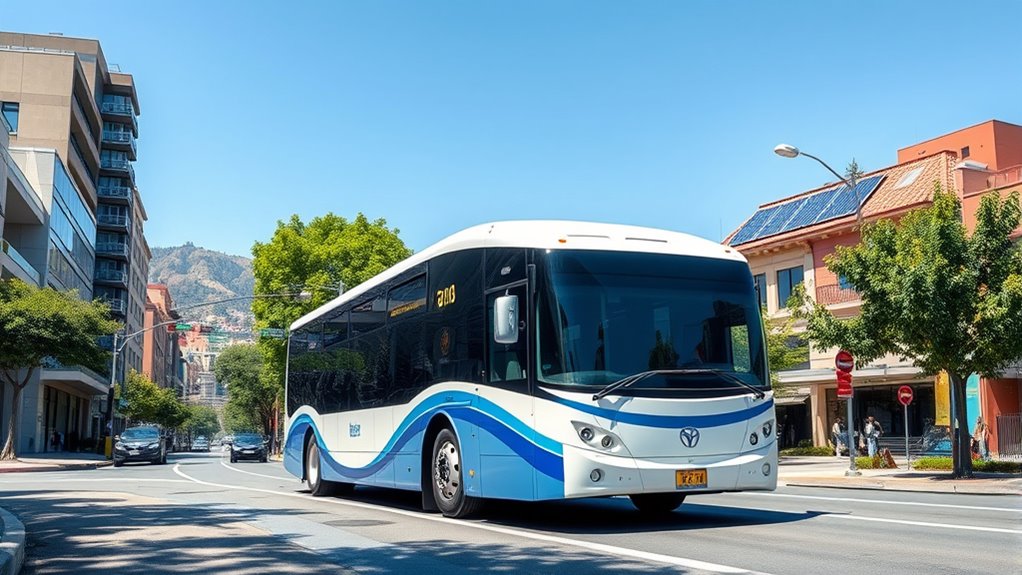
The environmental benefits of electric buses vary considerably across regions, primarily because their emissions depend heavily on the local energy mix. In areas powered mainly by renewable energy, like upstate New York, electric buses can reduce emissions by nearly 90% compared to diesel buses.
Conversely, in regions reliant on fossil fuels for electricity, the emissions savings are lower but still advantageous. As grids shift toward cleaner energy sources, electric buses will become even more environmentally friendly.
Keep in mind that factors like HVAC use in colder climates can impact overall emissions and energy consumption. Ultimately, regions with greener grids maximize electric buses’ climate benefits, making their deployment a more effective tool in reducing transportation-related emissions. Energy mix plays a crucial role in determining the true environmental impact of electric buses.
The Future Outlook for Electric Buses in Climate Action Strategies
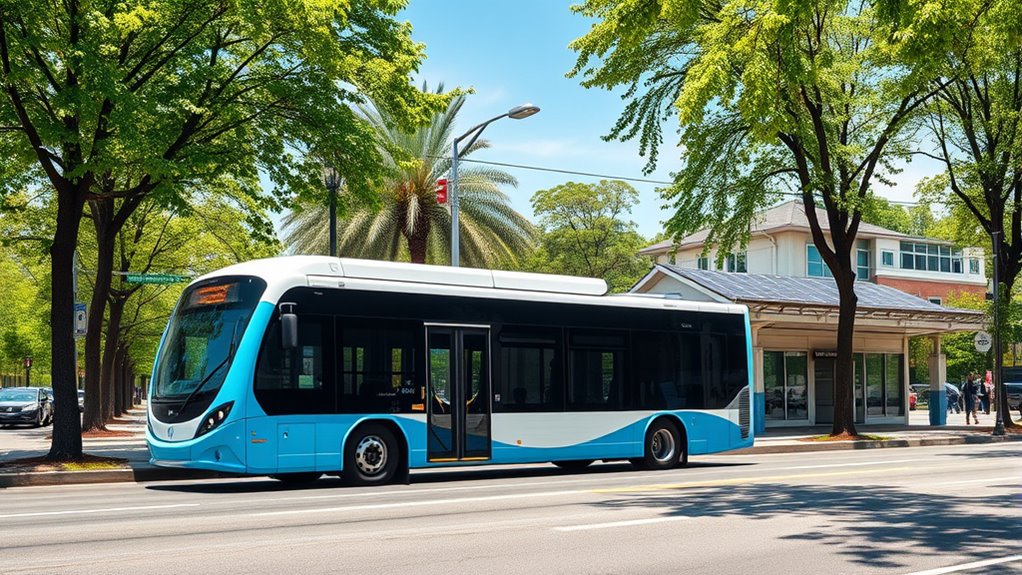
Electric buses are quickly becoming an essential component of climate action strategies worldwide, offering a cleaner and more sustainable alternative to traditional diesel fleets. You can expect rapid growth as advancements in battery technology improve range and efficiency, making electric buses more feasible for urban transit.
Governments aim for 60% of new bus sales to be electric or fuel cell by 2030, aligning with global climate goals. Infrastructure investments, like charging stations and upgraded grids, are critical to support this shift.
Electrification reduces greenhouse gases, air pollution, and health risks, especially in low-income communities. As renewable energy becomes more integrated into power grids, the environmental benefits multiply.
Frequently Asked Questions
How Do Electric Buses Compare With Natural Gas Buses in Emissions?
You might wonder how electric buses stack up against natural gas buses in emissions.
Electric buses emit markedly less CO2 per mile—about 1,078 grams compared to 2,364 grams from natural gas buses.
They produce no tailpipe emissions, reducing air pollution, and cut NOx emissions by roughly 70%.
Your choice impacts environmental health, especially when charged with renewable energy, making electric buses a cleaner, more sustainable option overall.
What Are the Main Challenges in Scaling Electric Bus Infrastructure?
You face several challenges when scaling electric bus infrastructure. Securing funding and managing high initial costs require strategic planning and investment.
You must optimize charging schedules and routes to guarantee efficiency while minimizing disruptions.
Overcoming infrastructure limitations involves finding suitable locations, upgrading facilities, and dealing with site power constraints.
Additionally, training staff and integrating technology are essential to maintain operations smoothly and support infrastructure growth.
How Do Battery Manufacturing Emissions Affect Overall Environmental Benefits?
You might wonder how battery manufacturing emissions impact overall benefits. While producing batteries does generate significant emissions and resource extraction impacts, the long-term operational advantages outweigh these initial costs.
Electric buses produce zero tailpipe emissions and improve air quality, especially when powered by renewables.
Are There Specific Regions Where Electric Buses Are More Cost-Effective?
You might think electric buses are equally cost-effective everywhere, but that’s not true. In regions with lower utility rates and strong government incentives, like California, you’ll see faster payback and bigger savings.
Urban areas with dense routes benefit more due to shorter charging times, while rural zones face infrastructure challenges.
Investing in electric buses becomes smarter where energy costs are low and support systems are robust, maximizing your financial and environmental gains.
What Policies Are Most Effective in Promoting Electric Bus Adoption?
You want to know which policies most effectively promote electric bus adoption. Focus on combining stringent emission standards with fiscal incentives like tax credits, grants, and low-interest loans.
Invest in charging infrastructure and develop strategic plans involving stakeholder engagement and route prioritization. These policies make electric buses more accessible, affordable, and practical, encouraging transit agencies to replace diesel fleets and accelerating the shift toward cleaner, sustainable transportation systems.
Conclusion
As you explore the shift to electric buses, you’ll find it’s a gentle yet powerful step toward a cleaner planet. With thoughtful investments and supportive policies, you can help create healthier communities and a brighter future. Embracing this change isn’t just about transportation—it’s about nurturing the environment and generations to come. So, consider how your role can spark this positive transformation, guiding us all toward a more sustainable, harmonious world.
